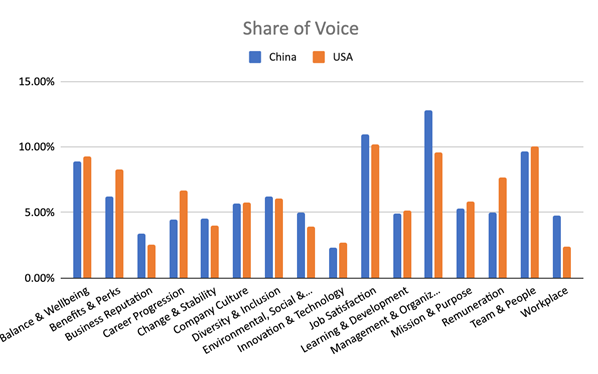
Do companies need to adapt their employer brand strategy depending on the country’s culture? A comparative study of China and the United States.
Introduction
One of the most significant challenges for many multinational companies (MNCs) is adapting their employer brand strategy to win talent in different countries. There is also no consensus on this question in academic research. According to some authors, due to cultural differences, people’s perceptions of employer attractiveness in one country are significantly different from the other; therefore, a company can’t have a universal employer brand strategy (Alnıaçık et al., 2014). On the other hand, some authors argue that companies can utilize a global approach to employer branding, which will also help reduce costs and optimize brand processes (Baum & Kabst, 2013).
To address this question, we used data to compare talent’s attention towards 16 dimensions of employer branding in two different countries: China and the United States. According to Hofstede’s cultural dimensions theory, these countries can be considered as the opposite poles.
Chinese culture is characterized by values of collectivism and long-term orientation, while the United States is characterized by individualism and short-term orientation (Hofstede et al., 2010). Collectivism is defined as a society in which people belong to in-groups that are supposed to look after them in exchange for loyalty. At the same time, individualism refers to a society in which people are expected to only look after themselves and their immediate family (ibid).
Long-term orientation means people are predisposed to long-term relationships and future gains while having great tolerance for current discomfort instead of short-term oriented societies, where people are motivated by short-term goals and immediate comfort (Hofstede, 2008).
This research aims to determine if dimensions of employer branding receive extra attention in China and the United States. It will be of particular interest to US companies with operations in China to learn more about the talent’s attention focus in the two countries. Besides, we will attempt to answer whether a global approach to employer branding should be utilized or whether companies should consider adapting their strategy according to culture.
First, we will discuss the research method and Link Humans EBI methodology. Next, the key findings will be presented along with the potential explanation using Hofstede’s cultural dimension theory and other Chinese cultural phenomena, such as emphasis on harmonious relationship (Guanxi, 关系)and importance of “having face” (You Mianzi, 有面子). Finally, in the concluding section, the findings will be summarised.
Research method
We looked at data from a selection of Fortune 500 companies representing FMCG and the tech sector during Q1-Q2 2021 (January to June 2021). The companies we researched have a strong presence within China and the United States, which allowed us to collect a representative sample of data. The data collected was publicly obtainable commentary from either employees, alumni, or candidates. The data was sourced from 17 US platforms, including Glassdoor, Indeed, LinkedIn, Comparably, and 10 Chinese platforms, such as Maimai, Kanzhun, Xiaohongshu, Sina Weibo, to name a few. From this, we were able to compile over 28,000 data points, with the United States accounting for 89% of the data, China for 11% of the data.
Our artificial intelligence (AI) categorized the data into 16 attributes according to our Employer Brand Index research methodology. Attributes represent 16 dimensions of the employer branding, such as Balance & Wellbeing, Career Progression, Management & Organization (to see the complete list, click here). Each attribute gets a score, based on a ratio of positive to negative commentary, along with a share of voice (SOV), which shows the amount of commentary in each attribute as a percentage of the total. This research will focus on SOV to see if there is a difference in talent’s focus on specific dimensions of employer brand in the two countries.
Key findings
The chart below represents the average SOV for the 16 attributes from the selected companies in China and the United States. From the chart, it is evident that most of the attributes receive a similar amount of SOV in China and the United States, apart from Management & Organization and Workplace, where the discussion is more prominent in China. Below we will analyze some of the potential reasons why Chinese talent places a greater focus on these two attributes.

Management & Organization
According to Link Humans’ EBI methodology, Management & Organization is defined as how people feel about the company’s management, leadership, organizational structure, and internal processes. This attribute has the highest SOV in China, and its SOV is also much higher than in the United States (12.78% vs. 9.60%). The word cloud below shows the disparity in the frequently occurring keywords in this attribute in China and the United States. In the word cloud, the size of the word is based on the frequency and the shade of the color from bright green to bright red, representing the sentiment of the keywords from mainly positive to mostly negative.

If we delve deeper into these keywords, firstly, we can see that the keywords “interview” and “interviewer” are the most frequently occurring in China. Clearly, in China, people emphasize candidate experience. They are eager to share on forums and social media if the interview process was smooth or if the interviewer was friendly and nice, or the opposite. Secondly, the discussion around managers also differs drastically between the two countries. As seen from the word cloud, the keywords “management” and “manager” are the most frequently used in the United States, and the sentiment is negative. At the same time, only 6.8% of commentary contained this keyword in China, and the sentiment is more positive than in the United States.
So why is Chinese talent not speaking about managers as much as talent does in the United States, and why is the sentiment not as negative?
Firstly, it can be explained by long-term orientation and the importance of the harmonious relationship (Guanxi, 关系) for Chinese people. As previously mentioned, Chinese society is characterized by long-term orientation, with a significant focus on the future and high tolerance for current discomfort (Hofstede, 2008). Even if there is dissatisfaction with managers, Chinese employees will be willing to adapt, which may explain less negativity from them. Besides, building relationships and developing connections with other people, the so-called Guanxi (关系), is emphasized in Chinese culture. Having a good relationship with a manager will also mean more opportunities for development, which according to Zhu and Wang’s (2014) research, is greatly valued by Chinese talent.
Secondly, we see fewer negative comments in China in Management & Organization and in other attributes. One of the potential reasons is the Chinese Cybersecurity law (中华人民共和国网络安全法) that went into effect in 2017 requiring that everyone that uses Chinese websites must register with real name and provide a phone number to verify their identity (实名认证) (Baidu Baike, 2021). This could explain the reluctance of Chinese talent to post negative commentary online. Indeed, only recently, a Pinduoduo employee was fired for posting on Maimai (the Chinese equivalent of LinkedIn) a photo of a colleague being carried out of the office on a stretcher (Baidu, 2021).
Workplace
According to Link Humans’ EBI methodology, Workplace is defined by how people feel about the physical space where they work. This attribute has a higher SOV in China, as compared to the United States. (4.75% vs. 2.42%). From the word cloud below, we can see that the most frequent keywords in China are very similar to those in the United States. People in both countries speak about office spaces, working from home, amenities such as onsite cafeterias and gyms.

The greater attention to the office environment from Chinese talent can be explained by collectivism and the cultural phenomenon of “having face” (You Mianzi, 有面子). In collectivist cultures, people tend to place more focus on social identity and belonging to the group, as opposed to focus on self-identity in more individualist societies, such as the United States (Hofstede, 2008). Also, “having face” is an essential phenomenon in Chinese culture and is key to understanding Chinese social behavior (Song, 2018). “Having face” is defined as social identity that is formed within social interactions through the attitudes of others (ibid). Thus, working in a comfortable fancy office with lots of onsite facilities helps Chinese people to “have face”, which means to build a favorable social image and to get recognition from other people.
Conclusion
To summarise, we looked at MNCs with a strong presence in China and the United States to analyze talent’s attention towards dimensions of employer branding in two countries. While most dimensions receive a similar amount of attention, Management & Organization gets considerably more attention in China. Our data showed that in China, people pay more attention to candidate experience, with “interview” and “interviewer” among the most popular keywords. On the contrary, Chinese people speak less about management. Workplace is another dimension of employer branding that receives more attention from Chinese talent. Hostede’s cultural dimensions theory and Chinese cultural phenomena, such as emphasis on harmonious relationship (Guanxi, 关系)and importance of “having face” (You Mianzi, 有面子), have been used to explain cultural differences in two countries.
From the above analysis, it can be concluded that while a global approach to employer branding may work, to achieve the best results, companies should customize employer brand strategy due to differences in talent’s attention focus in different countries.
At Link Humans, we help measure companies’ employer brands on a global level, and we can provide rankings and key insights per country. Moreover, we can keep track of the data volume coming from each country to see trends or patterns over time. The above can help companies inform their employer brand strategies, whether they believe in a holistic or a country-specific approach to employer branding.
References
- Alnıaçık, E., Alnıaçık, Ü., Erat, S., Akçin, K. (2014). Attracting talented employees to the company: do we need different employer branding strategies in different cultures? Procedia – Social and Behavioral Sciences, 150, 336-344.
- Baum, M., Kabst, R. (2013). How to attract applicants in the Atlantic versus the Asia-Pacific region? A cross-national analysis on China, India, Germany, and Hungary. Journal of World Business, 48, 175-185.
- Hofstede, G. 2008. Culture’s consequences: Comparing values, behaviours, institutions and organisations across nations, Shanghai Foreign Language Education Press.
- Hofstede, G., Hofstede, G.J., Minkov, M. (2010). Cultures and Organizations: Software of the Mind. The McGraw-Hill Companies.
- Song J.Y. (2018). What is face anyway?” Digital Commons @ George Fox University
- Baidu Baike, accessed on 20 September 2021: link.
- Baidu, accessed on 20 September 2021: link.
- Zhu, F., Wang, Z. (2014). Reconsidering the dimensionality and measurement of employer brand in the Chinese context. Social Behavior and Personality, 42 (6), 933-948.
- Tagged With:
- Culture
- Employer brand index
- Management
- Organization
- Research
- Workplace
STAY CONNECTED.
DATA-DRIVEN EMPLOYER
BRAND INSIGHTS.
Our newsletter is exclusively curated by our CEO, Jörgen Sundberg, for leaders who make decisions about talent. Subscribe for updates on The Employer Branding Podcast, new articles, eBooks, research and events we’re working on.



